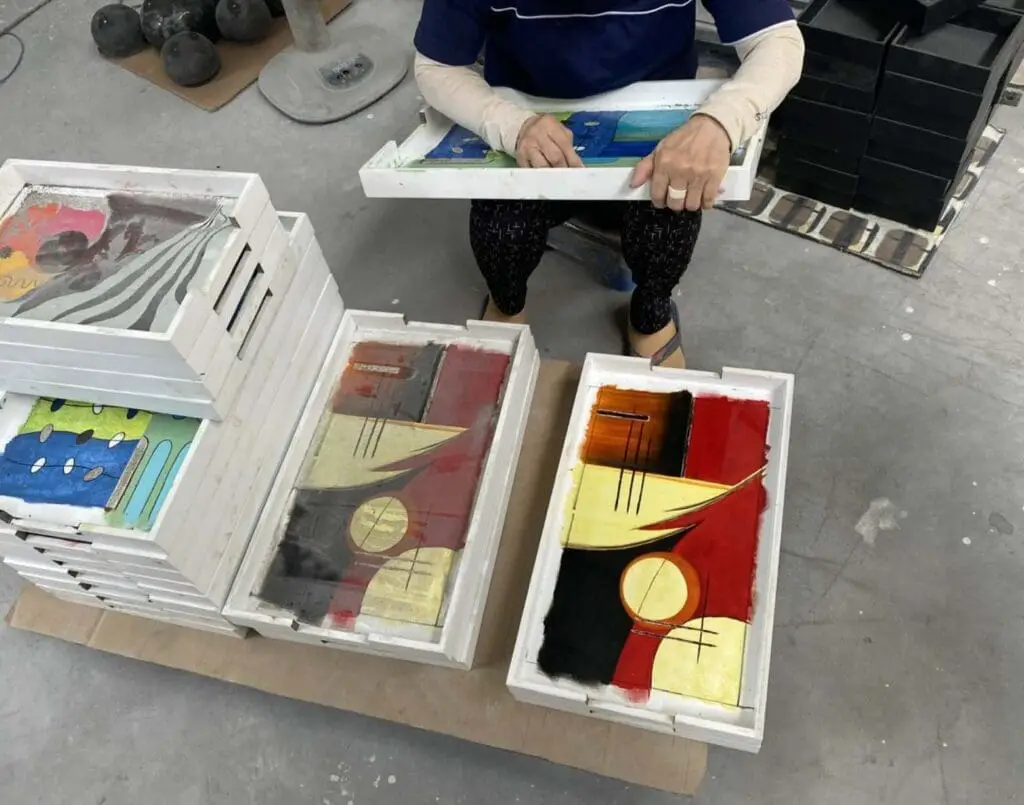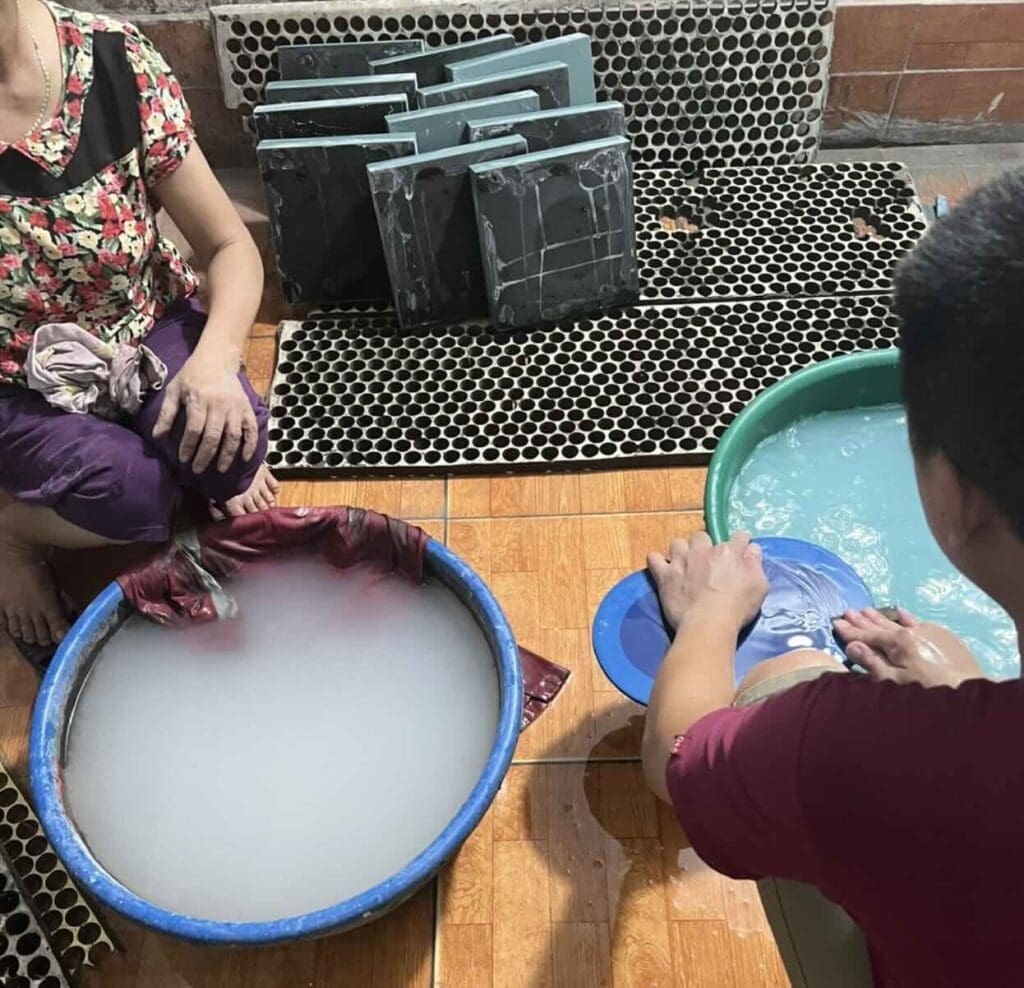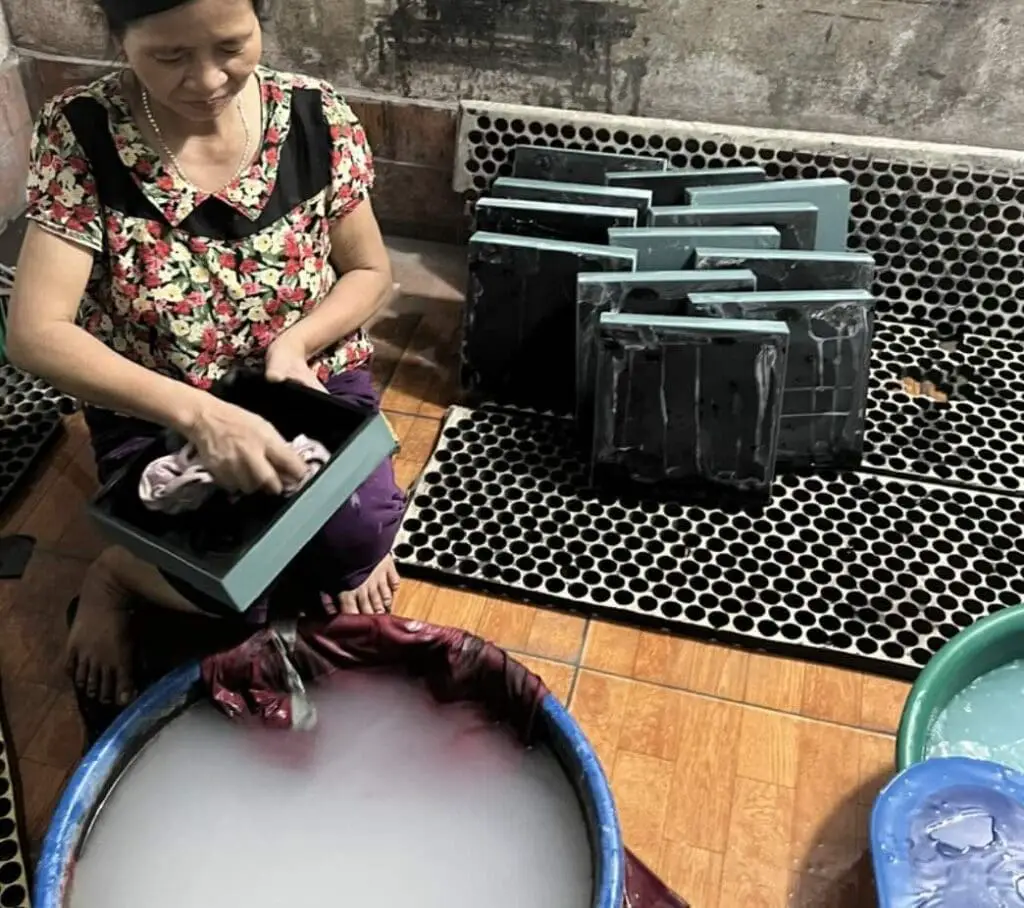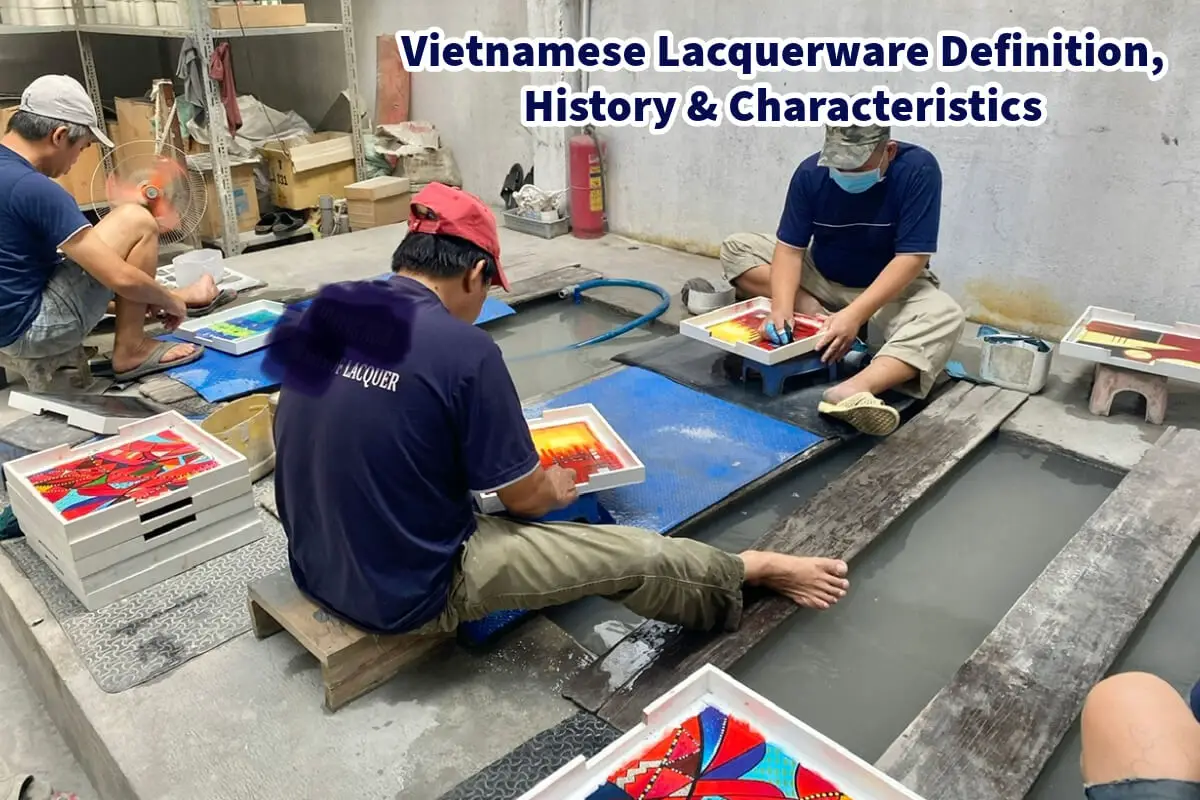The tradition of Vietnamese lacquerware extends back for centuries, deeply embedded in the nation’s culture. Especially notable are small villages surrounding Hanoi, where the art of lacquerware has been meticulously crafted in households for over 800 years.
Its intricate layering process distinguishes Vietnamese lacquerware from similar crafts in other regions. In Vietnam, artisans apply numerous coatings—sometimes as many as 18 to 30 layers—each painstakingly sanded before the application of the next. This method makes the creation of lacquerware in Vietnam a highly detailed and labor-intensive process, setting it apart in terms of complexity and craftsmanship.
Table of Contents
- The Intricacies Of Vietnamese Lacquerware: Definition, History, And Unique Characteristics
- 11 Unique Characteristics Of Vietnamese Lacquerware
- 1. Sourced From Local Trees
- 2. Multiple Coating Layers
- 3. Time-Intensive Process
- 4. Artistic Versatility
- 5. Deep Cultural Roots
- 6. The Sheen Factor
- 7. Durability And Longevity
- 8. Use Of Silver And Gold Leaf
- 9. Distinctive Vietnamese Motifs
- 10. Functional And Decorative
- 11. Eco-Friendly And Sustainable
- Related Content
The Intricacies Of Vietnamese Lacquerware: Definition, History, And Unique Characteristics
Vietnamese Lacquerware is a traditional art form that has captivated people for centuries, both within Vietnam and beyond its borders. Whether it graces functional household items or is displayed as standalone works of art, lacquerware has left an indelible mark on Vietnamese culture.
Vietnamese lacquerware boasts a storied past that spans over eight centuries, particularly in communities around Hanoi’s outskirts. Its intimate production scale sets this craft apart—numerous small-scale factories have diligently created lacquerware for several generations.
Remarkably, many of these enterprises are family-run businesses that have been involved in lacquerware production for centuries and continue to do so to this day.
Vietnamese Lacquerware: The Definition
To fully appreciate the artistry and utility of Vietnamese Lacquerware, it’s crucial to understand its primary ingredient: lacquer. Lacquer is a resin extracted from the sap of specific trees.
In Vietnam, this resin is most commonly harvested from the “cây sơn” tree, found in the mountains of Phú Thọ Province. The sap collection process is akin to rubber; workers incision into the bark and collect the sap that oozes out.
The term for lacquer in Vietnamese is “sơn mài,” and “tranh sơn mài” refers specifically to lacquer painting, which is a distinct art form in Vietnam. Unlike mere decorative techniques.
Vietnamese lacquer painting is a freestanding art form with a complex process that includes several stages, such as preparing the blackboard, outlining with chalk, polishing, and applying multiple layers of colored and clear lacquer, often accentuated with silver leaf.

The Making Of Vietnamese Lacquerware
Whether or not you are using Vietnamese lacquerware to make a box, tray, lamp base, furniture, or painting, the process is very similar. The creation of a Vietnamese lacquer painting is a meticulous and multi-step endeavor.
Here are some of the significant steps of Vietnamese lacquerware production:
- Preparing A Black Board: The base is often wooden and covered with black lacquer. This lacquer is applied and sanded several times.
- Outlining In Chalk: Artists use chalk to sketch the basic shapes and outlines of the artwork. In making a box or tray, we may skip this step if the box or tray is one color.
- Polishing: The chalk outlines are then polished to eliminate imperfections.
- Applying Colored Lacquer: One or more layers of colored lacquer are applied, depending on the desired effect.
- Silver Leaf Application: Silver leaves may be applied for a luxurious touch.
- Clear Lacquer Coat: Finally, a transparent layer of lacquer is applied to seal and protect the artwork.
All these steps are unique because the piece is hand-sanded between each lacquer. That is why Vietnamese lacquerware involves a lot of hand sanding between each step.
The lacquerware pieces we produce often have between 25 or more steps.
11 Unique Characteristics Of Vietnamese Lacquerware
Vietnamese lacquerware is a unique production type with some very unique characteristics. Below are some of the characteristics of Vietnamese lacquerware.

1. Sourced From Local Trees
One of the remarkable characteristics of Vietnamese lacquerware is its localization. The resin primarily comes from the cây sơn trees indigenous to Vietnam’s Phú Thọ Province, making it an entirely local craft.
2. Multiple Coating Layers
To achieve the incredible durability that Vietnamese lacquerware is known for, artisans apply several layers of lacquer, each meticulously sanded and polished before the next is applied.
3. Time-Intensive Process
The craft demands an investment of time. Completing a single piece can take weeks to months due to the required drying time between layers.
4. Artistic Versatility
The medium allows various artistic expressions, from paintings and decorative bowls to furniture and religious items.
5. Deep Cultural Roots
Lacquerware has historical and cultural relevance in Vietnam and is often used in religious ceremonies and traditional rituals, thus reflecting its integral role in Vietnamese life.
6. The Sheen Factor
The multiple layers of lacquer create a deep, lustrous sheen that captures and reflects light, adding another dimension to the artwork.

7. Durability And Longevity
Finished lacquerware pieces are incredibly durable and resistant to water, heat, and time—qualities that contribute to their lifelong usability.
8. Use Of Silver And Gold Leaf
For added luxury, some Vietnamese lacquerware incorporates silver or gold leaf, creating an opulent and reflective surface that adds richness to the piece.
9. Distinctive Vietnamese Motifs
Artisans often incorporate motifs and designs unique to Vietnamese culture and history, distinguishing them from lacquerware from other cultures.
10. Functional And Decorative
The versatility of Vietnamese lacquerware makes it suitable for practical items like furniture and bowls and purely decorative pieces like paintings and sculptures.
11. Eco-Friendly And Sustainable
The primary materials, including the lacquer and the wooden or bamboo bases, are renewable and biodegradable, aligning with modern sustainability values.
Vietnamese lacquerware is not just an art form; it’s a testament to the country’s rich cultural heritage and ingenuity. From its localized sourcing of materials to its multi-layered, labor-intensive process and the unique characteristics that result from this,
Vietnamese lacquerware embodies an intricate blend of utility, beauty, and tradition. Whether it is a radiant painting or a resilient piece of furniture, it carries the spirit and the skill of the Vietnamese artisans who have honed this craft for centuries.
This art form beckons us not merely to look but to see—the work, the culture, and the history it represents.
At Mondoro, we specialize in crafting various traditional Vietnamese lacquerware items. We’ve got everything from boxes and trays to lamps, furniture, and other home decor accessories. If you’re interested in learning more about our offerings, we’d be delighted to discuss how we can meet your needs.
Find out more about how Mondoro can help you create, develop, and manufacture excellent home decor and home furniture products – don’t hesitate to contact me, Anita. Check out my email by clicking here or become a part of our community and join our newsletter by clicking here.
Mondoro gives out a FREE Lookbook to anyone interested. You can receive a copy of our latest Lookbook by clicking here.
Listen to our Podcast called Global Trade Gal. You can find it on all major podcast platforms. Try out to listen to one of our podcasts by clicking here.
Subscribe to our Mondoro Company Limited YouTube Channel filled with great videos and information by clicking here.
Related Content
Lacquerware And Mother Of Pearl – 10 Reasons We Love Them!
We love lacquerware and mother-of-pearl products. Lacquerware and mother of pearl are high-quality handmade products that can produce a variety of finishes and techniques in various shapes and sizes. You can use the materials for all kinds of home decor and home furniture products.
You can discover more by reading Lacquerware And Mother Of Pearl – 10 Reasons We Love Them! by clicking here.
Where Did Lacquerware Originate? An Interesting History
Lacquerware originated from China; some lacquerware has been found to come from 10,000 BC. The Chinese brought the lacquerware technique to many other parts of Asia, in particular Japan and Vietnam. Each country has developed its lacquerware techniques, colors, and shapes.
You can discover more by reading Where Did Lacquerware Originate? An Interesting History by clicking here.
What Is Vietnamese Lacquerware? 11 Unknown Lacquerware Facts
Vietnamese lacquerware is a paint process where lacquer paint is used to make lacquerware. This lacquer paint traditionally comes from the sap of the lacquer trees. The Vietnamese lacquerware has many layers; each must be carefully sanded, properly dried, and prepared. These layers help make Vietnamese lacquerware a unique art.
You can discover more by reading What Is Vietnamese Lacquerware? 11 Unknown Lacquerware Facts by clicking here.


